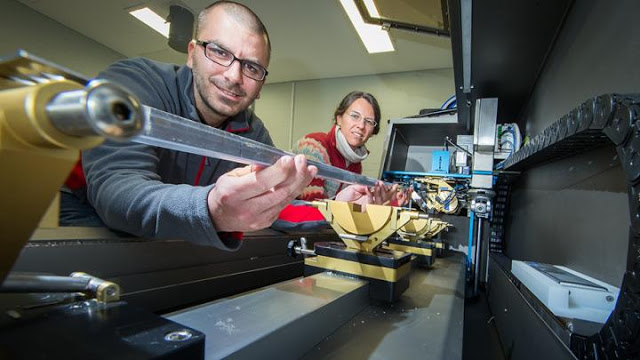| Online: | |
| Visits: | |
| Stories: |

| Story Views | |
| Now: | |
| Last Hour: | |
| Last 24 Hours: | |
| Total: | |
135,000 Years Ago Global Warming Caused Dramatic Ice Sheet Collapse
The team found the events 135,000 years ago caused the planet to warm in a different way to the end of the most recent ice age about 20,000 to 10,000 years ago.
The findings will help scientists understand the processes that control Earth’s dramatic climate changes, said the leader of the study, Dr Gianluca Marino of The Australian National University (ANU).
Dr. Gianluca Marino and Dr. Katharine Grant load a sediment core into an X-ray fluorescence scanner.
Credit: Stuart Hay, ANU
“Ice-age cycles may superficially look similar to one another, but there are important differences in the relationships between melting of continental ice sheets and global climate changes.”
The team, which includes researchers from ANU as well as the Universities of Southampton and Swansea in the UK, has published their findings in Nature.
At the end of an ice age the continental ice sheets, ocean, and atmosphere change rapidly. Scientists have previously only been able to reconstruct in detail the changes at the end of the last ice age.
“We have compared the fluctuations at the end of an earlier ice age, and we found that the patterns were different,” said co-author Professor Eelco Rohling, from both ANU and the University of Southampton.
“At the end of the older ice age, 135,000 years ago, we found that a dramatic collapse of the Northern Hemisphere ice sheets into the North Atlantic Ocean suppressed the ocean circulation and caused cooling in the North Atlantic.”
“North Atlantic cooling was counterbalanced by Southern Ocean warming that then destabilised Antarctic land ice, causing a continuation of melting that eventually drove sea level rise to several meters above the present,” he said.
This is very different from the end of the last ice age, said Dr Marino.
“The northern hemisphere ice-sheet collapse and climate change did not occur at the same time, and that caused much less warming in Antarctica,” he said.
The team used precisely-dated cave records and marine sediments from the Mediterranean region to reconstruct the sequence of changes in all critical climate parameters.
Source: http://www.ineffableisland.com/2015/06/135000-years-ago-global-warming-caused.html



